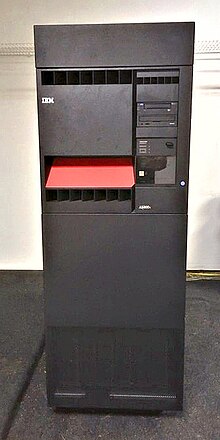
Back IBM AS/400 Catalan AS/400 Spanish IBM AS/400 Finnish AS/400 Hungarian IBM AS/400 Italian AS/400 Polish AS/400 Portuguese AS400 Vietnamese
 IBM AS/400e model 730 | |
| Also known as | AS/400e, eServer iSeries, eServer i5, System i |
|---|---|
| Manufacturer | IBM |
| Type | Midrange computer |
| Release date | June 1988 (Announced) August 1988 (Release) |
| Discontinued | Sep 30, 2013 |
| Operating system | OS/400 (later known as i5/OS and IBM i) |
| CPU | IMPI, IBM RS64, POWER |
| Predecessor | IBM System/38,IBM System/36 |
| Successor | IBM Power Systems running IBM i |
| Related | IBM System p |
The IBM AS/400 (Application System/400) is a family of midrange computers from IBM announced in June 1988 and released in August 1988. It was the successor to the System/36 and System/38 platforms, and ran the OS/400 operating system. Lower-cost but more powerful than its predecessors, the AS/400 was extremely successful at launch, with an estimated 111,000 installed by the end of 1990 and annual revenue reaching $14 billion that year,[1] increasing to 250,000 systems by 1994,[2] and about 500,000 shipped by 1997.[3]
A key concept in the AS/400 platform is Technology Independent Machine Interface[a] (TIMI), a platform-independent instruction set architecture (ISA) that is translated to native machine language instructions. The platform has used this capability to change the underlying processor architecture without breaking application compatibility. Early systems were based on a 48-bit CISC instruction set architecture known as the Internal Microprogrammed Interface (IMPI), originally developed for the System/38.[4] In 1991, the company introduced a new version of the system running on a series of 64-bit PowerPC-derived CPUs, the IBM RS64 family.[5] Due to the use of TIMI, applications for the original CISC-based programs continued to run on the new systems without modification, as the TIMI code can be re-translated to the new systems' PowerPC Power ISA native machine code. The RS64 was replaced with POWER4 processors in 2001, which was followed by POWER5 and POWER6 in later upgrades.
The AS/400 went through multiple re-branding exercises, finally becoming the System i in 2006. In 2008, IBM consolidated the separate System i and System p product lines (which had mostly identical hardware by that point)[6] into a single product line named IBM Power Systems.[7][8] The name "AS/400" is sometimes used informally to refer to the IBM i operating system running on modern Power Systems hardware.[9]
- ^ Elms, Teresa (29 April 1991). "Side road to success". Computerworld. p. 27.
- ^ Korzenioski, Paul (14 February 1994). "AS/400 in the LAN environment". InfoWorld. p. 52.
- ^ IBM (23 January 2003). "IBM AS/400". IBM.com. International Business Machines Corporation. Retrieved 20 March 2022.
- ^ David McKenzie. "Notes for storage research". Archived from the original on October 8, 1999.
- ^ Soltis, Frank G. "When Is PowerPC Not PowerPC?". The 400 Squadron. Archived from the original on January 8, 2008.
- ^ Timothy Prickett-Morgan (2008-04-07). "Bye Bye System p and i, Hello Power Systems". IT Jungle. Retrieved 2021-10-09.
- ^ Niccolai, James (April 2, 2008). "IBM merges System i and System p server lines". InfoWorld.
- ^ Timothy Prickett Morgan (2008-04-07). "It's Official: Now We're Power Systems and i for Business". itjungle.com. Retrieved 2021-03-15.
- ^ Alex Woodie (2017-07-17). "Of Course i's Not The AS/400". IT Jungle. Retrieved 2021-11-22.
Cite error: There are <ref group=lower-alpha> tags or {{efn}} templates on this page, but the references will not show without a {{reflist|group=lower-alpha}} template or {{notelist}} template (see the help page).